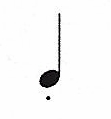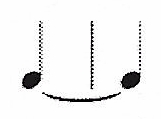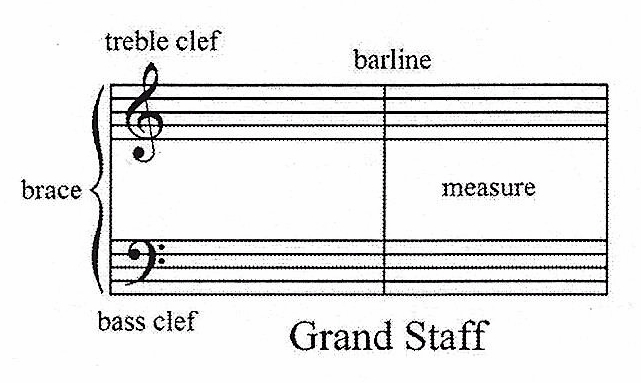









|
NAYSA'S
ONLINE MUSIC PORTFOLIO (OMP)
FOR PIANO LESSONS
NAYSA'S HOME PAGE NAYSA'S GLOSSARY OF TERMS NAYSA'S AUDIO SAMPLES/VIDEO LINKS
NAYSA'S SHEET MUSIC TO DOWNLOAD NAYSA'S GAMES AND LEARNING TOOLS NAYSA'S PERSONAL REPERTOIRE
Form: * Logging Practice Minutes *
Hi Naysa! Here's your own Glossary of Terms, which includes only those terms we've discussed so far...
| TERMS FOR CM: |
| Tempo Markings (slowest to fastest): | largo, lento, adagio, andante, andantino, moderato, allegretto, allegro, vivace, presto |
| LEVEL Prepatory |
 | piano: soft |
 | forte: loud |
 | accent: play louder, stressed, marked |
 | slur: a curved line that indicates legato - to play smoothly |
 | staccato: not connected, crisp |
 | tie: a curved line connecting notes of the same pitch - hold for full value of both notes |
 | repeat sign: play the music again |
| dynamics: | symbols or terms that indicate loud or soft |
| fine: | the end |
| D.C. al fine (da capo al fine): | return to the beginning and play to fine |
 | fermata:: hold longer |
| rit, ritard, ritardando: | gradually slower |
| a tempo: | return to the original tempo |
bar line
measure
treble clef
bass clef
brace
grand staff
|  |
COMPOSERS |
| Robert Starer - Sketches in Color |
Sketches in Color-Set One
Robert Starer composed the Sketches in Color: Seven Pieces for Piano, Set One in 1963, the year his son Dan took piano lessons. He comments about these pieces, “While looking for sounds to match colors, I
observed Dan in order to discover what children like and dislike. Children do not like bombast or boredom and they see through pretentiousness much better than adults do.” These little miniatures are quite appealing and popular to all students.
Starer prefaces these pieces on the first page, “Sketches in Color (Seven Pieces for Piano) are intended for study as well as for performance. The titles are obviously rather personal, since associations between sounds and colors
are arbitrary at best. The pieces employ different 20th century techniques to create their different moods.” The seven movements include “Purple,” “Shades of Blue,” “Black and White,” “Bright Orange,” “Grey,” “Pink,” and
“Crimson.” These are for students prepared to play literature at the intermediate level.
“Purple,” a slow and colorful piece, is a bitonal piece with the right hand playing solid triads over open fourths or fifths in the left hand. Intermittent passages occur with the right hand and left hand playing the same melodic line three octaves apart.
“Shades of Blue” has appeal as a jazzy blues piece. It is performed at a moderately fast tempo. The melodic line is played by the right hand over a perfect fifth in the left hand that moves mostly in stepwise motion.
“Black and White” is also bitonal, but this time the left hand is playing broken chords. The hands take turns playing on all white or all black keys. The left hand opens playing on the white keys while the right hand plays on the black keys. This pattern continues throughout the piece, alternating sections where the hands switch back and forth from white to black, and black to white keys. The right and left hand never play on the same “color” of keys simultaneously.
“Bright Orange,” perhaps one of the most popular pieces in this set, is a fast driving piece with jazzy syncopations. The right hand melody drives to the ff climax on a strong dissonance. The melody is played over root position triads with the final cadence ending in C major.
“Grey” is an excellent choice to study the creation of a twelve-tone row. The series is defined in the score as well as the inversion, retrograde, and retrograde inversion. This is also an excellent choice to develop pp playing.
“Pink” represents one of the finest examples of Starer’s lyrical style. The melody is written in the right hand, with frequent changes between duple and triplet eighth notes. Meter changes occur intermittently, requiring a good sense of rhythm and pulse. The frequent change of tonal centers supports a beautiful melody with well rounded phrases.
“Crimson” is another driving and exciting piece. Starer utilizes asymmetrical rhythms to enhance the energy that defines this bright color. Written in 7/8 time, the rhythm is grouped by 4+3 eighth notes. This asymmetric pulse is constant throughout the piece, providing the driving force which culminates in an authentic cadence.
The pieces of this set are summarized in Table 3-3. This guide may be useful to choose which piece of the set works best for the individual student and the particular skill required.
Table 3-3
Sketches in Color-Set One
| Mvt. | Title | Teacher’s Choice | Pianist’s Guide | Basic Skill |
| 1 | Purple | Grade 6 | Level 6-7 | Polytonality |
| 2 | Shades of Blue | Grade 5 | Level 5 | Jazz Style, Parallel Motion |
| 3 | Black and White | Grade 6 | Level 5 | Bitonality |
| 4 | Bright Orange | Grade 6 | Level 6-7 | Jazz Syncopation |
| 5 | Grey | Grade 7 | Level 6 | 12 Tone Row |
| 6 | Pink | Grade 8 | Level 6 | Lyricism |
| 7 | Crimson | Grade 8 | Level 7 | Asymmetric Rhythms (7/8) |
Sketches in Color-Set Two
This set also has seven movements with each named after a different color. Starer describes these as “… more advanced than Set One, both in the demands they make on the player and in the compositional techniques employed.” In Gail Lew’s edition of the Sketches in Color-Set Two, she
comments on Starer’s works, “Robert Starer has developed an individual style marked by innovative tonalities and energetic rhythms. Sketches in Color- Set One and Sketches in Color-Set Two are imaginative, refined, interesting, vital, and musically alive. This music retains and sharpens the
student’s musical interest, whether he is a child or an adult. This is done while developing the techniques necessary for mastery of the instrument.” The individual movements are titled “Maroon,” “Aluminum,” “Silver and Gold,” “Khaki,” “Pepper and Salt,” “Aquamarine,” and “Chrome
Yellow.” This set is considerably more dissonant and rhythmically more complex than the first set.
“Maroon” is characterized by dramatic changes in dynamics with dissonant tone clusters, colored by the imaginative use of the pedal. The tempo is moderate, with dynamic ranges from pp to ff. The blending of the sounds and rhythm create a timeless aura without melody. This piece is truly an experiment in sound and texture.
“Aluminum” is a fast and clearly articulated piece. Successful performance requires big dynamic contrasts and articulated staccato eighth notes. The polytonal harmonic structure is clearly defined with right hand and left hand alternating white and black keys.
“Silver and Gold” presents a very imaginative legato melody in the right hand played against a detached twelve tone ostinato. This slow and unique piece is one of the more eclectic pieces in this set.
“Khaki,” a short march, requires close attention to articulation and pulse. The left hand grace notes act as a drum roll on the strong beats. This is especially effective when performed with precise rests and a strong marked beat.
“Salt and Pepper” presents the listener with great contrasts. Changes in dynamics are extreme and sudden. This piece requires an excellent sense of pulse and the ability to cleanly articulate changes in register quickly.
“Aquamarine” most closely resembles a jazzy blues style even though it is written in 15/8 time. The melody is written in the right hand, with third inversion seventh chords moving in parallel motion in the left hand. Though this is a sedate piece, it does require a strong lyrical style and the ability to control a crescendo over three fifteen beat measures.
“Chrome Yellow” demands a strong sense of rhythm. The frequent meter changes require a steady eighth note pulse that must be maintained throughout the piece. With small tone clusters in the right hand, this is the most dissonant in this set.
Sketches in Color-Set Two is summarized in Table 3-4. The suggestions in grading may be applied when assigning these to a student.
Table 3-4
Sketches in Color-Set Two
| Mvt. | Title | NMCP | Pianist’s Guide | Basic Skills |
| 1 | Maroon | Grade 7 | Level 7-8 | Sharp Dynamic Contrasts and Pedaling |
| 2 | Aluminum | Grade 7 | Level 8 | Articulation, Dynamics |
| 3 | Silver and Gold | Grade 7 | Level 7-8 | Lyricism and Balance |
| 4 | Khaki | Grade 7 | Level 7-8 | Tone Clusters, Articulation |
| 5 | Pepper and Salt | Grade 7 | Level 7-8 | Contrasts in Dynamics and Articulation |
| 6 | Aquamarine | Grade 8 | Level 7-8 | Lyricism, Jazz Style, Rhythm |
| 7 | Chrome Yellow | Grade 8 | Level 8 | Changing Meters |
Robert Starer, Sketches in Color, Set One (New York, MCA Music Publishing, 1964)
Robert Starer, Sketches in Color- Set Two (New York, MCA Music Publishing, 1973)
from "Tracing the Stylistic Elements of Robert Starer’s Pedagogical Works to the Twilight Fantasies and Sonata for Piano, No. 3 by Richard Gerard Van Dyke
|
|












